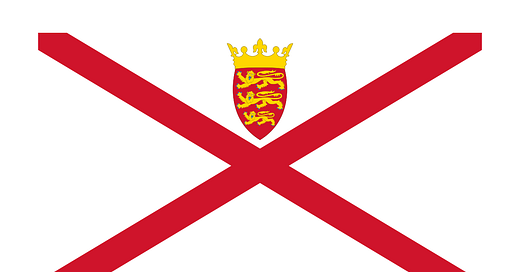Fort Regent tunnel opens for traffic
Jersey banker caught stealing from Jersey States + Steamer strikes rocks off Jersey
Fort Regent tunnel opens
The tunnel beneath St Helier’s Fort Regent opened for vehicles this week in 1970, providing a much-needed shortcut for traffic travelling through the town. The tunnel, which had been approved seven years earlier, was designed to cater to the level of traffic at the time of its design, with capacity for just one lane of traffic in either direction.
It links the Route de la Liberation and Route du Fort and required the compulsory purchase of several private buildings and the relocation of a statue of Queen Victoria. The project cost £450,000 to complete, with an overall length of 253m (830ft). The tunnel is almost 9m wide and 7m tall, and its construction required the removal of more than 50,000 tons of rock, with the walls, floor, and ceiling reinforced by concrete.
The tunnel has been upgraded several times over the years, and although initially designed solely for cars, narrow, fenced pathways were eventually added along either wall due to public pressure
Jersey banker caught stealing from the Jersey States
Philip Gosset, the treasurer of the Jersey States, was charged with embezzlement this week in 1886. He was simultaneously employed by the Jersey Banking Company, where he served as the managing director. Following the bank’s collapse, Gosset was accused of misappropriating £37,000 of public funds and illegally disposing of foreign bonds in an attempt to sustain the bank's operations. As a result of his actions, he faced several charges of embezzlement.
The bank's sudden closure led to a refusal to pay out to account holders, ultimately causing other companies with significant deposits to go bankrupt. Gosset was arrested and stood trial less than two months later. He was found guilty on three charges and sentenced to five years' penal servitude. A professional accountant testified that the bank's books were written in a way that concealed its true liabilities, which were estimated to be hundreds of thousands of pounds. The bank’s other directors were found not guilty of some charges but were declared guilty by a jury for not properly assessing the bank's financial state before declaring it to be healthy.
Women stranded on Seymour Tower
Two women were stranded on Seymour Tower this week in 1987. The tower, built in 1782, is located a mile and a quarter off Jersey’s east coast and is linked to the island at low tide. The women, who had been riding their horses close to the tower in thickening fog, lost their way back to the shore before the tide turned, leaving them and their horses stranded outside the locked tower.
They were eventually rescued by the lifeboat after it was alerted by their failure to return home. This dramatic rescue was filmed and featured in an episode of the BBC’s 999 program, which recreated the event.
Two tales from the occupation
Pearl Vardon, a Jersey-born school teacher, was tried this week in 1946 for aiding the enemy during the Second World War. She had fallen in love with a German officer, Oberleutnant Siegfried Schwatlo, and followed him to Germany. During her time there, she broadcasted propaganda criticising the Allies and praising Germany.
She was arrested on April 30, 1945, and later pleaded guilty to the charge of "doing an act likely to assist the enemy." Vardon was sentenced to nine months' imprisonment.
The motive behind her actions was believed to be the desire to avoid separation from the German officer she loved. After her release, Vardon and Schwatlo were married.John Lingshaw, a Jersey-born former Royal Militia member, was deported by the occupying forces during World War II for having served in the Royal Militia. Despite being interned in Bavaria, Lingshaw saw his deportation as an opportunity to offer his services to Germany. He joined German State Radio's New British Broadcasting Service in Berlin, teaching English and monitoring the BBC's output. He lasted only over a year before returning to Bavaria in 1944.
This week in 1946, he was tried for offences under the Defence Regulations and sentenced to five years' penal servitude. Lingshaw died in Sheffield in 1975.
Steamer strikes rocks
The SS Lyntre, a coal-filled steamer, struck rocks off Noirmont Point this week in 1952. The ship, carrying anthracite coal from Swansea to Jersey, was holed below the waterline, took on water and listed to the starboard side. The captain's wife was lowered into the lifeboat with the ship's log and other documents, while the captain remained onboard to await the tug. The ship was eventually towed stern-first to the harbour at St Helier.
This event occurred on a leap year's day when the wind was still and the sea was smooth. The ship put out an SOS at 6:05 am, and the Jersey lifeboat, Elizabeth Rippon, came to her aid 20 minutes later. By that point, the ship was powerless and drifting due to damage to her rudder and propeller.
Jersey Chamber of Commerce founded
The Jersey Chamber of Commerce was founded this week in 1768 by the 18th-century shipping magnates of the island. The Chamber was established to better represent the vital interests of the island's business community to those in power. Over its 250 years, it has significantly widened its focus to encompass all parts of the island economy, including finance and tourism.
While the Chamber itself has no legislated power, its members' ability to establish an agreed position and stick to it gives it enormous leverage, particularly as its membership grows. The Chamber has been able to lobby for better harbour facilities and to have a greater say in the fishing industry. It remains the oldest Chamber in the Commonwealth, but is relatively sprightly when compared to the oldest in the world, which is the Chambre de Commerce founded in Marseilles in 1599.





